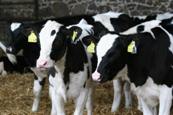Dairy farms decreased their carbon footprint

Cornell University researchers found that modern milk production system has a smaller carbon footprint than did mid-20th century farming practices.
"As U.S. and global populations continue to increase, it is critical to adopt management practices and technologies to produce sufficient high-quality food from a finite resource supply, while minimizing effects upon the environment," Jude Capper, the study’s lead author, said.
The study showed the carbon footprint for a gallon of milk produced in 2007 was only 37 percent of that produced in 1944. Improved efficiency has enabled the U.S. dairy industry to produce 186 billion pounds of milk from 9.2 million cows in 2007, compared with only 117 billion pounds of milk from 25.6 million cows in 1944. That, said the scientists, has resulted in a 41 percent decrease in the total carbon footprint for U.S. milk production. Efficiencies also resulted in reductions in resource use and waste output.
The research conducted with Professor Dale Bauman appears in the Journal of Animal Science.











